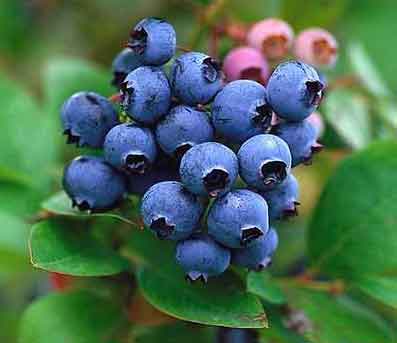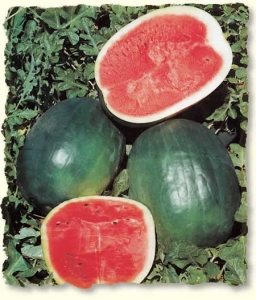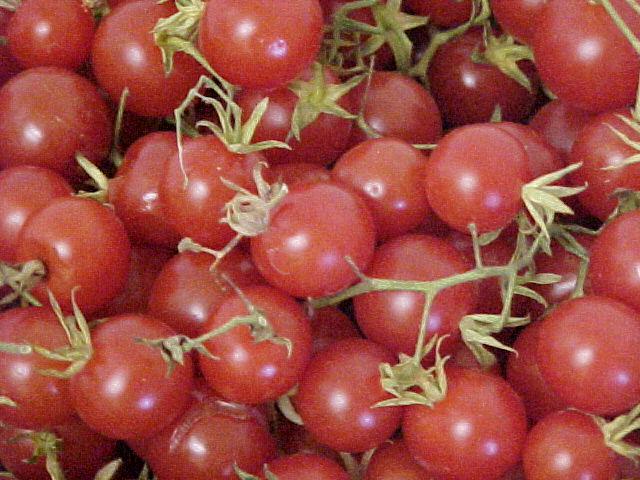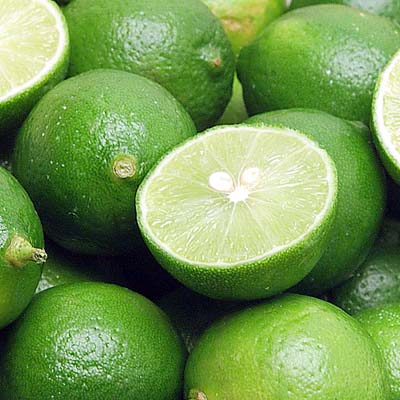Florida Fresh Produce... So much more than Oranges!
By Louis Luzzo
Ask people across the country to give a few examples of fresh Florida produce and you will invariably hear, "Oranges and Grapefruits." Most Americans would be completely amazed at the % of the other Florida grown fruits and vegetables that make their way to kitchen tables all across the nation.
In 2005 for instance, Florida ranked first in the nation for sales of snap beans, 49% of the total U.S. value of sales for fresh market tomatoes, 31% of the total U.S. value of sales for fresh market cucumbers, 44% for bell peppers, 31% for watermelons. Most folks are also not aware that Florida sugarcane production ranks #1 in the Nation.
Examples of Florida Fresh Produce:
 Blueberries: Since the early 90's until present day, the blueberry industry is Florida's fastest growing agriculture industry. In Florida and other various hot sections of the United States, many of these blueberry species have been interhybridized and complexly mixed to produce a wide array of plants adapted for hot climates. Mostly grown in the central and northern parts of Florida, they are generally available in springtime from April thru June. They are high in antioxidents and just a 1/2 cup contains almost 2 grams of fiber. They do not ripen after picking, being at peak flavor when they are harvested, so be sure to select firm, fresh plump berries with a deep purple to blue-black skin. Refrigerate for up to 3 days and be sure not to store them with tomatoes, apples, peaches, or any other fruit that produce ethelyne gas, as they will lose freshness more quickly.
Blueberries: Since the early 90's until present day, the blueberry industry is Florida's fastest growing agriculture industry. In Florida and other various hot sections of the United States, many of these blueberry species have been interhybridized and complexly mixed to produce a wide array of plants adapted for hot climates. Mostly grown in the central and northern parts of Florida, they are generally available in springtime from April thru June. They are high in antioxidents and just a 1/2 cup contains almost 2 grams of fiber. They do not ripen after picking, being at peak flavor when they are harvested, so be sure to select firm, fresh plump berries with a deep purple to blue-black skin. Refrigerate for up to 3 days and be sure not to store them with tomatoes, apples, peaches, or any other fruit that produce ethelyne gas, as they will lose freshness more quickly. Strawberries: While most native Floridians are very aware of Florida's strawberry production, the rest of the nation might be quite surprised to find out that Plant City, Florida is known as the Winter Strawberry Capital of the World and is home to the World renowned Strawberry Festival every February. The United States is the leading producer and supplies about 20 percent of the world's strawberries, with California growing about three-fourths of U.S. strawberries with Florida being the next largest producer. Grown mostly in the central region of the state, they are available from November thru April. High in potassium, strawberries are a catabolic food.
Strawberries: While most native Floridians are very aware of Florida's strawberry production, the rest of the nation might be quite surprised to find out that Plant City, Florida is known as the Winter Strawberry Capital of the World and is home to the World renowned Strawberry Festival every February. The United States is the leading producer and supplies about 20 percent of the world's strawberries, with California growing about three-fourths of U.S. strawberries with Florida being the next largest producer. Grown mostly in the central region of the state, they are available from November thru April. High in potassium, strawberries are a catabolic food.  Catabolic foods are famous for allowing the body to use more calories to consume them, than the food actually contains. That is, of course, if you keep from loading them with sugar! Florida strawberries are sweet and juicy, will refrigerate for up to 4 days, and will keep in the freezer for up to 12 months. It's always best not to wash strawberries until you are ready to use them.
Catabolic foods are famous for allowing the body to use more calories to consume them, than the food actually contains. That is, of course, if you keep from loading them with sugar! Florida strawberries are sweet and juicy, will refrigerate for up to 4 days, and will keep in the freezer for up to 12 months. It's always best not to wash strawberries until you are ready to use them. Watermelons: Florida growers annually harvest approximately 24,000 acres of watermelons, representing about 56 percent of the total U.S. harvest. Florida is the only U.S. supplier of watermelons from December to April. Mostly grown in the western part of the state from Collier to Columbia County, Florida watermelons are available mostly from May thru July, but harvesting also takes place in November, December and April. Lycopene, which is known to reduce the risks of certain types of cancer, is watermelon's nutritional claim to fame, as well as providing 300mg of potassium and a generous dose of Vitamin A per serving. Picked when fully ripe, always look for a creamy yellow spot on the underside which indicates it has been sun ripened. Try it in a salad or just cool off on a hot day with a sweet and juicy slice. This is one of my personal favorite summer snacks and while generally thought of as a fruit, it is a cucurbit, related to cabbage, cateloupes and cucumbers.
Watermelons: Florida growers annually harvest approximately 24,000 acres of watermelons, representing about 56 percent of the total U.S. harvest. Florida is the only U.S. supplier of watermelons from December to April. Mostly grown in the western part of the state from Collier to Columbia County, Florida watermelons are available mostly from May thru July, but harvesting also takes place in November, December and April. Lycopene, which is known to reduce the risks of certain types of cancer, is watermelon's nutritional claim to fame, as well as providing 300mg of potassium and a generous dose of Vitamin A per serving. Picked when fully ripe, always look for a creamy yellow spot on the underside which indicates it has been sun ripened. Try it in a salad or just cool off on a hot day with a sweet and juicy slice. This is one of my personal favorite summer snacks and while generally thought of as a fruit, it is a cucurbit, related to cabbage, cateloupes and cucumbers.
 Fresh Market Tomatoes: Every day across our nation, Florida puts tomatoes on the table. Tomatoes first came to Florida in 1870, when farmers planted them in Alachua County. Now tomatoes are Florida's No. 1 "vegetable" crop. (Yes that's right, it's not a vegetable, it's actually a fruit! You guys are so smart!) Florida produces 40% of the fresh-market tomatoes available in the United States. From Heirloom, Cherry to Florida Everglades (pictured), the variety of fresh Florida tomatoes is endless. Grown in north, central and south Florida, they are abundantly available from September thru June. The most common misconception about tomatoes is that they need to be refrigerated. Not true, as refrigeration breaks down the enzymes in the tomato and actually causes it to lose flavor. Best bet is to ripen them on the counter, then keep in a cool place, only refrigerating once they are cut open. Tip: Keep tomatoes stem-up to prevent bruising and always keep them out of direct sunlight.
Fresh Market Tomatoes: Every day across our nation, Florida puts tomatoes on the table. Tomatoes first came to Florida in 1870, when farmers planted them in Alachua County. Now tomatoes are Florida's No. 1 "vegetable" crop. (Yes that's right, it's not a vegetable, it's actually a fruit! You guys are so smart!) Florida produces 40% of the fresh-market tomatoes available in the United States. From Heirloom, Cherry to Florida Everglades (pictured), the variety of fresh Florida tomatoes is endless. Grown in north, central and south Florida, they are abundantly available from September thru June. The most common misconception about tomatoes is that they need to be refrigerated. Not true, as refrigeration breaks down the enzymes in the tomato and actually causes it to lose flavor. Best bet is to ripen them on the counter, then keep in a cool place, only refrigerating once they are cut open. Tip: Keep tomatoes stem-up to prevent bruising and always keep them out of direct sunlight.
Florida Citrus: Okay, so I couldn't talk about produce without speaking of the citrus Florida is truly famous for, Key Limes! Ahh, you thought I was going to say oranges, didn't you? C'mon, keep up. This is 'the other produce' issue!
Though Florida is known for Key Lime Pie, Key limes were only grown commercially in southern Florida and the Florida Keys, until the 1926 hurricane wiped out the citrus groves.
 The growers replaced the Key Lime trees with Persian Lime trees because they are easier to grow, pick, and due to the much thicker skin, more economical to ship. There are still many Key Lime trees throughout the Florida Keys and though commercial production is only on a very small scale now, they do seem to be making a slight comeback as a Florida crop. Key limes are small, somewhat larger than a walnut, oval in shape with a thin yellowish rind which are prone to splotchy brown spots. They are aromatic and very juicy, with a stronger and more complex acidic flavor than Persian limes. Both Persian and Key Limes have a higher sugar and citric acid content than lemons, and Key limes are more acidic than Persian.
The growers replaced the Key Lime trees with Persian Lime trees because they are easier to grow, pick, and due to the much thicker skin, more economical to ship. There are still many Key Lime trees throughout the Florida Keys and though commercial production is only on a very small scale now, they do seem to be making a slight comeback as a Florida crop. Key limes are small, somewhat larger than a walnut, oval in shape with a thin yellowish rind which are prone to splotchy brown spots. They are aromatic and very juicy, with a stronger and more complex acidic flavor than Persian limes. Both Persian and Key Limes have a higher sugar and citric acid content than lemons, and Key limes are more acidic than Persian.
So, when thinking of Florida Fresh Produce, think outside the box and look for all the wonderful varieties of fruits and vegetables 'The Sunshine State' has to offer. I bet you never thought about sending the relatives up north a box of Florida snap beans instead of oranges and grapefruits now did you?


